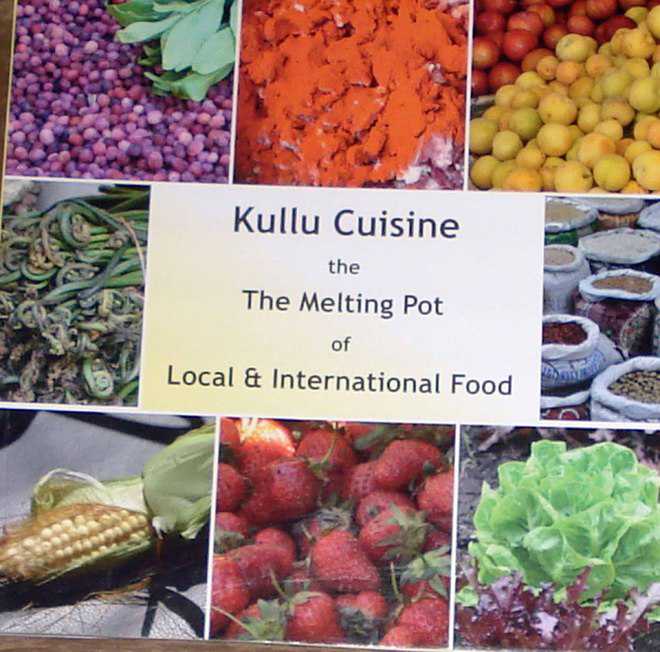Shriniwas Joshi
When Vineet Chawdhry, Additional Chief Secretary, sent, in the Facebook, photographs of the food that tickled his taste-buds at Mani Ram Dhaba (MRD) adjacent to Jana Waterfalls near Naggar, I picked up the recently published book ‘Kullu Cuisine’ compiled and edited by known writer Minakshi Chaudhry (see photo) and searched for MRD.
Another reason for doing so was that a blog says, “There is a nice restaurant at the waterfall offering you local dishes.” There are many names: Sanjha Chullah on way to Manikaran; Mamu ka Dhaba, Bhuntar; Siddu Market, Dhalpur; Shringi Vatika, Ghiyagi on the Banjar-Jalori Pass road; dhaba at Jalori Pass and a few names of sweet shops in ‘Kullu Cuisine’ but not MRD.
The book, however, is a veritable treasure of local and international food available in Kullu district. Reading the book and enjoying tasteful photographs, we come to know that in Kullu, cooking is an artist’s affair. Neither too much shadow nor too much sun is there - neither excessive colours nor dominant flavours. It is joie de vivre to enjoy exotic culinary treasures in the soft climate of Kullu.
Soups of different flavours whet the appetite and then we have the Japanese cuisine based on rice with miso soup and an emphasis on seasonal ingredients at Chopsticks or Cosa Bella Vista at Manali. By the way, ‘Bella Cosa’ in Italian means ‘Beautiful House’.
We get grilled fish here, raw too as sashimi or in sushi. Vietnamese food, considered as one of the most health-giving foods, is available at ‘Lazy Dog’ at Old Manali. Myanmar Food at City Choice, Kullu, serves several Myanmar dishes, besides Mohinga, a traditional breakfast dish, considered to be the national dish of that country by many. For Korean Sushi and Black Curry, Kim chi Radish, Sticky Rice, Fresh Horse Radish, Aubergine Pickle and Dark Soya Sauce, a visit to Korean Kitchen or O-One at Vashisht is required. Besides these, one can have Spanish, Italian, Mexican and French food at Moon Dance Café, Valentino, Sunshine etc at Manali.
The book is divided into eight chapters – Himachali offerings, Kullu delights, The Chef Recommends, The Exotic, The Popular, The Oriental, The Surprise and From Farm to Kitchen. I have already detailed the flavours of The Exotic and from Kullu Delights, I pick up Minakshi’s green collection from the forest. First is ‘Lingri’. In north India, it is known as lingda. Its botanical name is pteridium aquilinum. It is in the form of stalks. The tips of the stalks coil around themselves like snakes. Tender stalks are used as vegetable. No special technique is required for cooking lingri. Wash it, remove the skin, cut it into small pieces and season it in oil with spices.
Soosh or Choonch is found along the running water. It was new for me till I went to Sipur and a colleague showed me the bed of Choonch there. Minakshi says that it has to be cooked like saag or made into tasty savoury chutney which is generally taken with rice. Bartheya, phaphra, jharka, sanchal and bichu booti are the other names mentioned in the forest wealth. Most of these are to be taken with caution and under the guidance of an experienced eye.
Among these, bichhu booti or uritica diocia often called stinging nettle is taken as tea. These days Mela Ram Sharma, a botanist, is taking tea made of stinging nettle leaves and speaks high of its effect on his aching legs.
It is said it is very effective in removing dandruff, correcting menstrual problems and checking prostate enlargement.
The Surprise chapter has cuisines from three countries – Turkey, Greece and Egypt. Why surprise? I do not know. But these foods are available at World Peace at Vashisht, Ever Green at Kasol, Valentino at Kullu and at Johnson’s.
Published by the District Cultural Council and the Dussehra Committee, the book’s food specialist is Neeraj Chaudhry with three decades of experience in the hospitality sector and the photographer is Daman Sondhi whose work on Devtas and Dussehra of Kullu have received lots of acclaim.
TAILPIECE
Minakshi writes that jharka is a rare plant with elongated leaves and only experienced persons can locate it. Once found, its leaves are to be plucked keeping absolutely quiet. If someone says even ‘jharka’, its leaves go bitter.
— The writer is a retired bureaucrat
Unlock Exclusive Insights with The Tribune Premium
Take your experience further with Premium access.
Thought-provoking Opinions, Expert Analysis, In-depth Insights and other Member Only Benefits
Already a Member? Sign In Now










